Above: Class A1 No. 60132 is prepared for turning on the 70-foot turntable at Grantham Loco in August 1949. Photograph by Peter Wilkinson
by John Clayson
Here we explore the story behind a century of locomotive turning at Grantham, from 1862 to 1963.
1. Introduction
First, we'll look at why railways required locomotive turning facilities, and the available options.
Why Locomotives Require Turning
Locomotive turning was an essential operation at most engine sheds and passenger termini in the days of the steam railway. Nearly all steam locomotives, except those which spent their working lives on shunting duties, were intended whenever possible to travel 'chimney first' because:
- they rode more smoothly and safely, especially through curves and junctions;
- footplates were optimised for forward travel in terms of the layout of the controls and the driver's position, visibility of the line ahead, and the shelter of the crew;
- technically, the valve gear design and valve arrangements were usually set up in favour of forward gear, aiding efficiency and reducing wear;
- boiler safety - if the chimney is 'downhill' on a steep rising gradient there is a greater risk of low water level causing overheating of the firebox;
- ...and, of course, the profile of streamlined locomotives such as the A4s could only be effective if they were travelling forward!
There were exceptions to this rule. For example, some articulated types of steam locomotive were specifically devised to operate effectively when running in either direction.
Locomotive turning facilities became redundant on main line railways in Britain during the 1960s because nearly all diesel and electric locomotives are designed to travel equally well with either end leading.
The First Turntables
Turntables may predate the main line railways, because they were probably used on some horsedrawn waggonways. By the 1830s, at the principal stations of the earliest main line railways there were rotating circular platforms with inset rails. They were operated manually. Goods wagons or passenger carriages could be transferred, one at a time, to another set of rails at right angles, and then, using another similar turntable, onto a parallel track. Three turntables are seen below, in the foreground, at the Crown Street, Liverpool, terminus of the Liverpool & Manchester Railway in 1833.
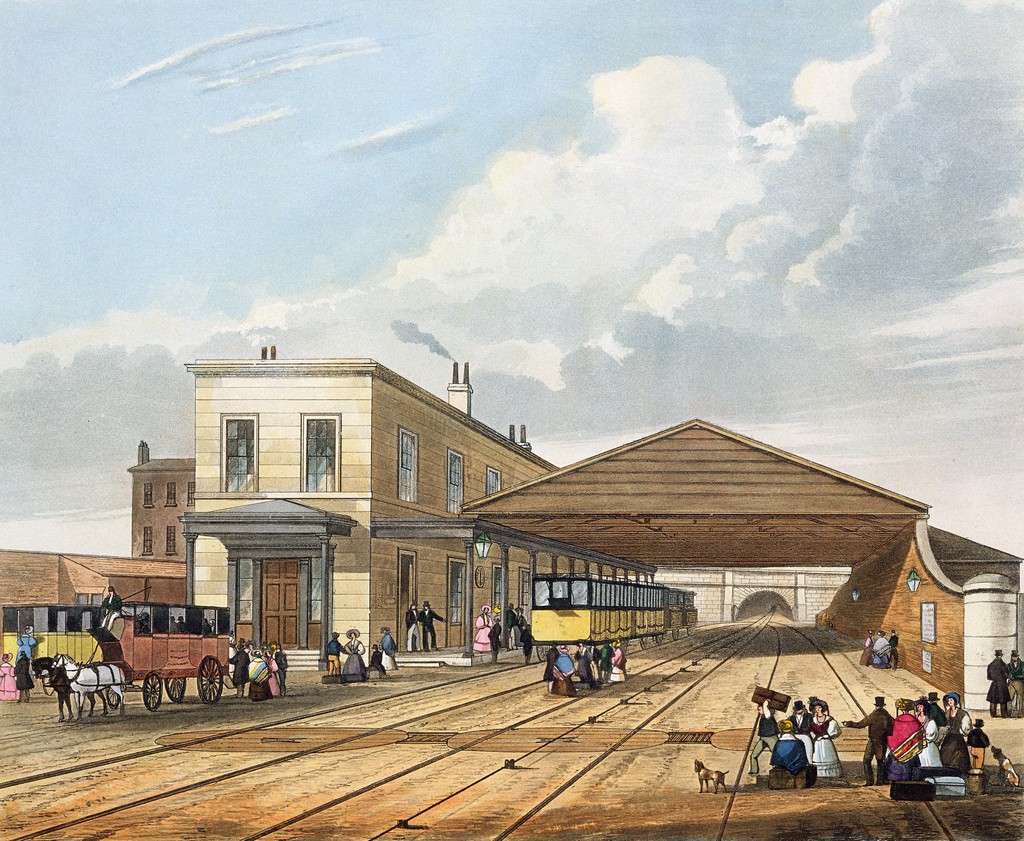
Though of limited capacity, these small turntables occupied less space than a set of points. They survived in goods yards into the 20th century, including at Grantham as shown below.
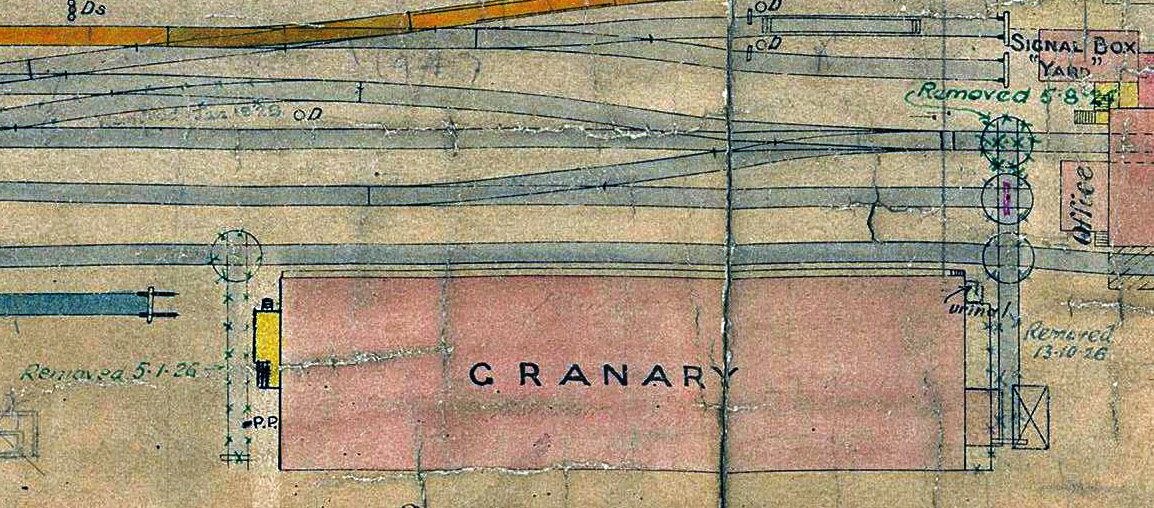
Locomotive Turntables
To turn locomotives a larger and much more substantially engineered device was needed. The rotating part was a strong, centrally pivoted girder on which the locomotive to be turned was positioned so that its weight was as well balanced as possible. Here is a description published in 1930:
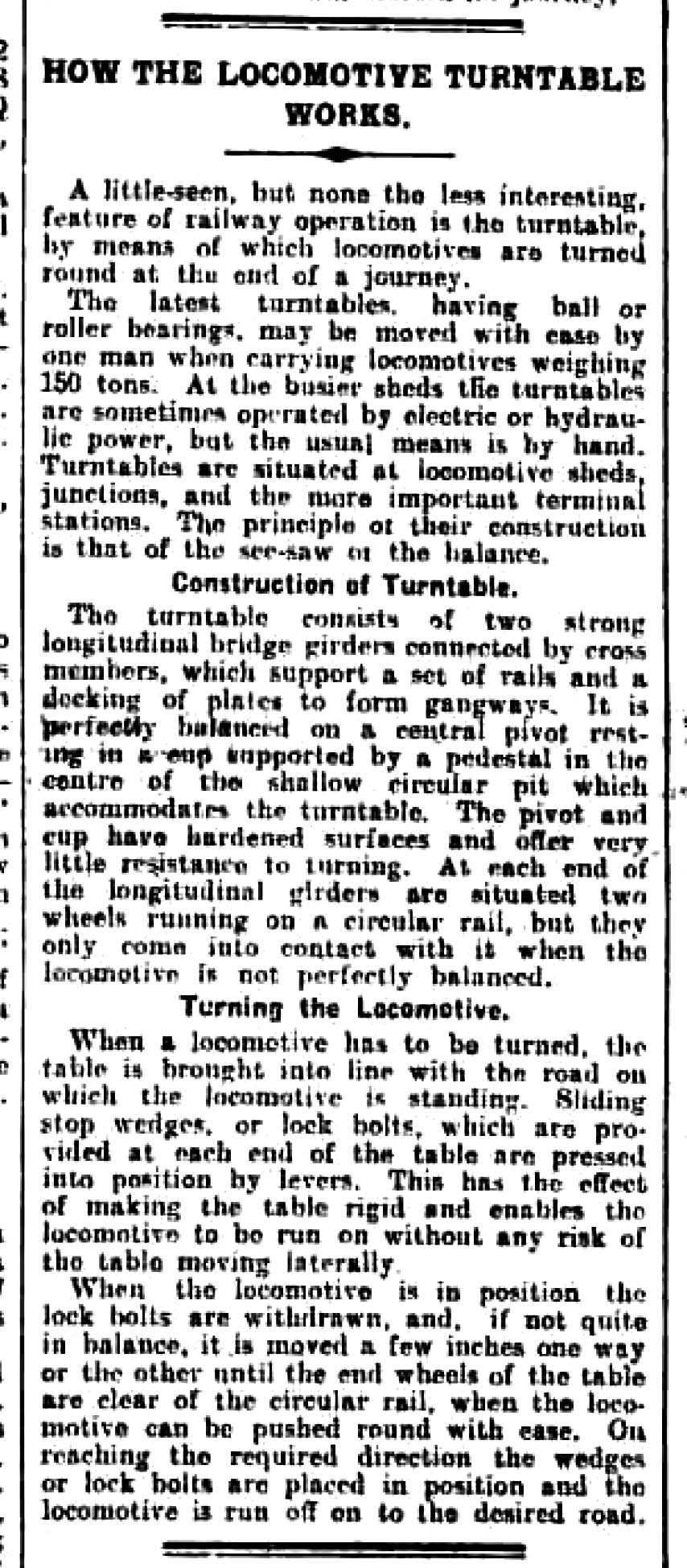
From The British Newspaper Archive http://www.britishnewspaperarchive.co.uk/
Image © THE BRITISH LIBRARY BOARD. ALL RIGHTS RESERVED.
All but the largest and most modern locomotive turntables were manually powered by the crew, who pushed against extension bars at each end. The masonry surrounding the turntable had a trackway of raised treads to provide a foothold. In Britain, a large steam locomotive of the 1930s-1960s weighed up to 170 tons when fully prepared with coal and water.
Compared with alternative methods of turning locomotives turntables were compact, but they required specialist maintenance. A serious breakdown, especially of the central pivot bearing, could disable the turning facility for days awaiting repair.
Alternatives to Turntables
The usual alternative to a turntable is a geometrical arrangement of track which, when traversed by a locomotive (or, indeed, a train), has the effect of reversing its direction of travel. The most common are (i) the reversing or return loop, where the track curves round through 360°and re-joins itself, forming a balloon shape, and (ii) the triangular junction (known as a 'Wye' in the US).
Such track layouts can either be part of the local railway operational infrastructure or, more rarely in the UK, they were specifically constructed for the purpose of locomotive turning.
Triangles occupy a large area of land, but they consist of commonplace track components. Faults can speedily be fixed by the local permanent way gang.
2. A Summary of Locomotive Turning Facilities at Grantham
Grantham became fully equipped for its future role as a locomotive changeover point on the East Coast Main Line in 1862. Improvements to the shed facilities included the installation of a locomotive turntable, essential because it was necessary to prepare main line locomotives for duty in either direction.
There were turntables at Grantham Loco from 1862 until 1950. In 1951 a compact 'crossover triangle' was set out on land to the west of the shed. Grantham's turning triangle remained in use until the shed closed in 1963.
To the north of Grantham, remote from the shed, a variety of triangular junction turning facilities have been available. They were used if turning facilities at the shed became disabled, though they placed a significant extra burden on shed staff because of the need to travel several miles out and back.
The best-known is the former triangular junction at Barkston which was in operation between 1882 and 1972. An alternative option, via Barkston South Junction, Barkston East Junction and Allington Junction, was available between 1875 and 2005.
Since 2005 the 'Allington Chord' has, in theory, provided a turning triangle facility. However, since the end of the regular use of steam locomotives turning has become unnecessary for the normal operational needs of the railway, so the local signalling arrangements at Allington do not provide for the set of moves required for turning.
3. Locomotive Turntables at Grantham
So far as we know there have been five turntables at Grantham shed, occupying four different sites. There was a single turntable available between 1862 and 1897, then two for 50 years until around 1947, and one again until 1950.
For ease of identification we are identifying them as Turntables 'A' to 'E' in order of installation, but of course they were never known as such when in service.
Turntables 'A' and 'B': 19th century era
Diameter 40 feet; in service 1862 to c. 1903, about 41 years
'Turntable A', Grantham's first turntable, was installed in about 1862. It was situated on the east side of the Engine Shed (later to become known as the 'Old Shed'), opposite the south end of the Western Platform. It was 40 feet in diameter.
'Turntable B' is said to have been a relocation of 'Turntable A' to a new site, opposite the north end of the station, in about 1889. However, there is a turntable shown at both sites on the map below, which was surveyed in 1885, so this point needs further research.
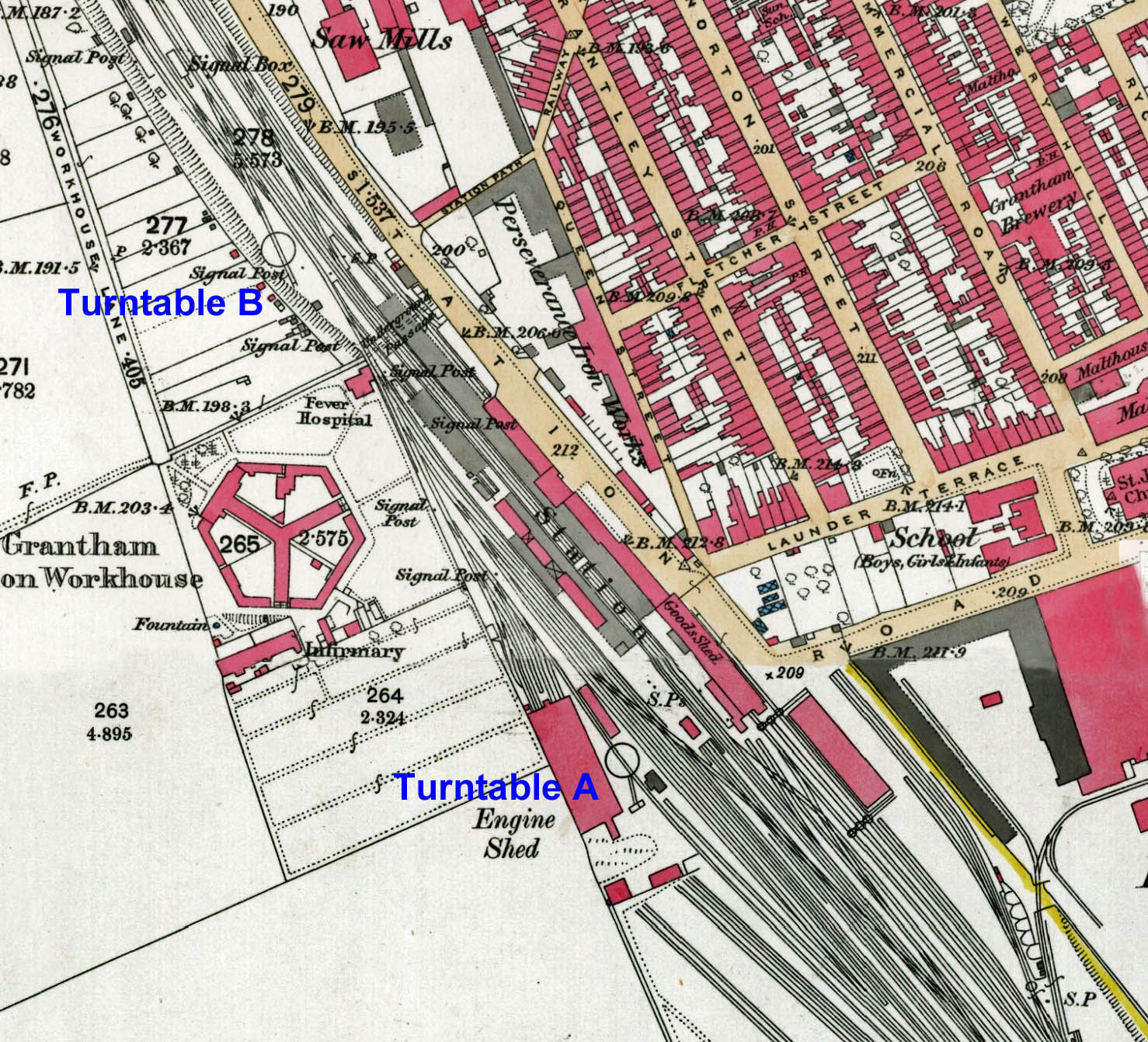
Grantham North signal box is near the top left corner. The distinctive hexagonal building is the town's Victorian workhouse. The GNR bought this land when the institution was relocated to Dysart Road in the early 1890s so they could widen the congested northern approach to the station.
Reproduced with the permission of the National Library of Scotland.
Turntables 'A' and 'B' were suitable for the 4-2-2, 2-4-0 and 0-6-0 locomotives used by the GNR during the 19th century.
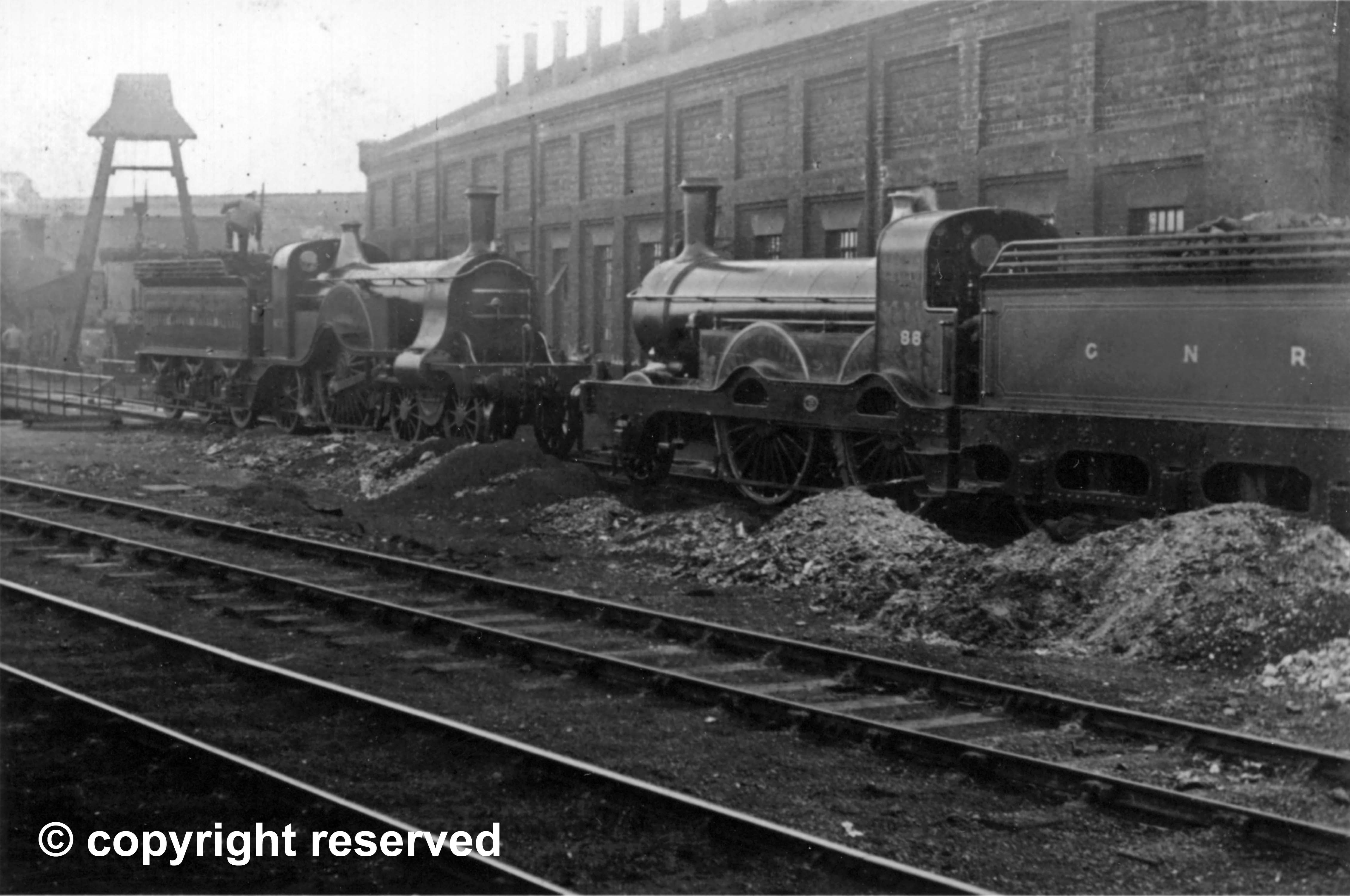
The building on the right was originally built in about 1855 as a two-road carriage shed. A loco shed adjoined it on the west. In about 1863 the two buildings were amalgamated under the Loco department.
Photograph by P. W. Pilcher; print kindly lent by Graham Cloxton.
A version of this photograph which shows a little more of the turntable appears on page 92 (top) of 'GNR Engine Sheds Vol. 1: Southern Area'. It is credited 'Collection Kenneth Leech'.
Access to 'Turntable B' was improved in 1892.
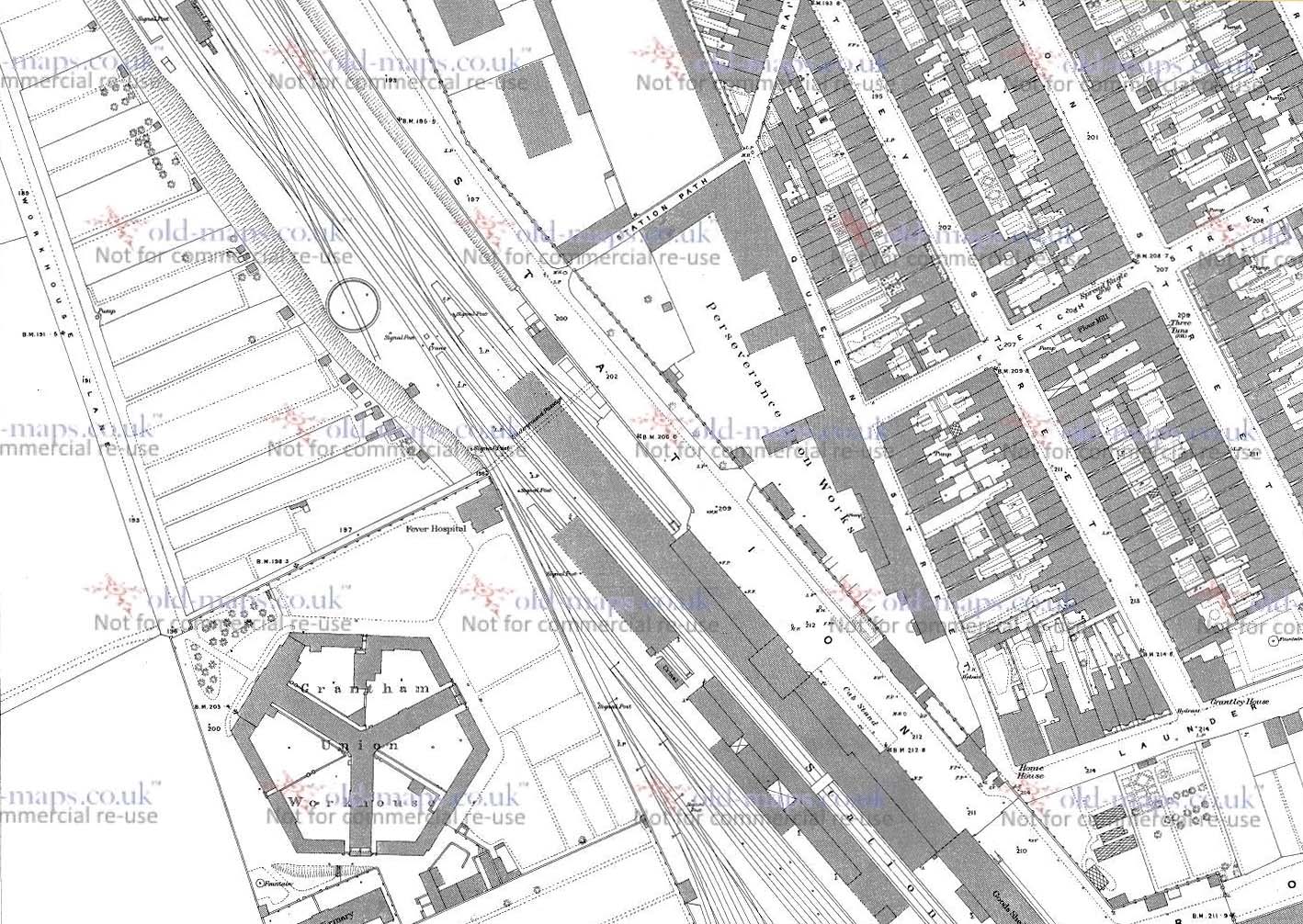
We believe the following accident took place on 'Turntable B', though it could have been at 'Turntable C' which had been brought into use the previous year.
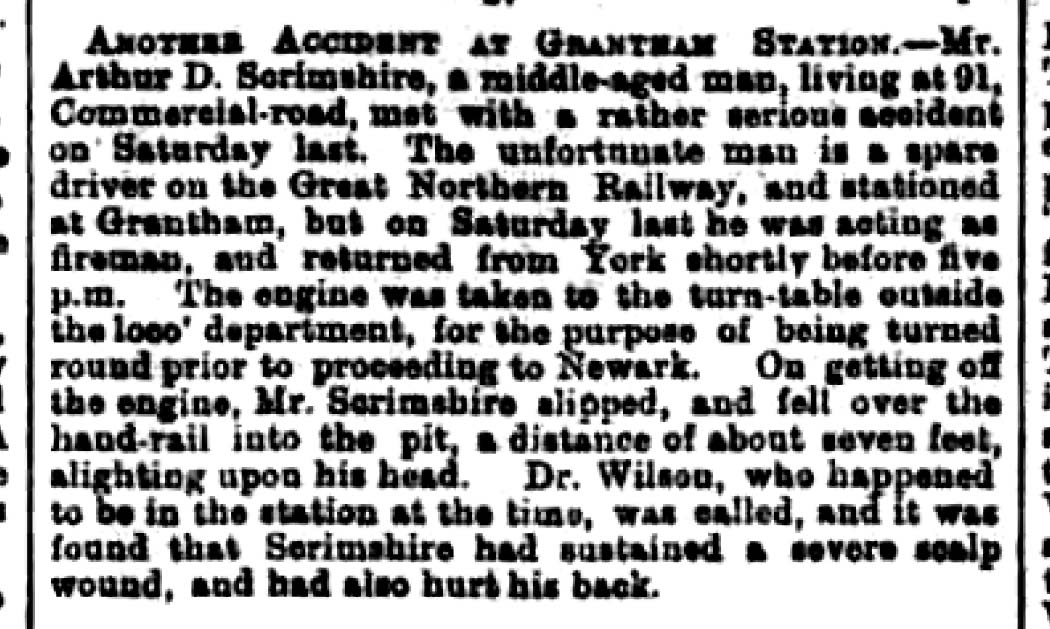
From The British Newspaper Archive http://www.britishnewspaperarchive.co.uk/
Image © THE BRITISH LIBRARY BOARD. ALL RIGHTS RESERVED.
Arthur D. Scrimshire was the uncle of Alfred Scrimshire, who was Chief Clerk in the Stationmaster's office in the 1930s and appears in the photograph here.
'Turntable B' was removed in about 1903 to enable the construction of a new goods line to the west of the passenger station.
'Turntable C': the 'small Atlantic' era
Diameter 52 feet; in service 1897 to c. 1947, about 50 years
'Turntable C', 52 feet in diameter, was installed in 1897 to enable the Great Northern Railway's new fleet of 4-4-2 'Atlantic' locomotives to be operated from Grantham shed. It was built at the south end of the Loco site, next to Springfield Road, at the same time as the adjacent 'Top Shed'.
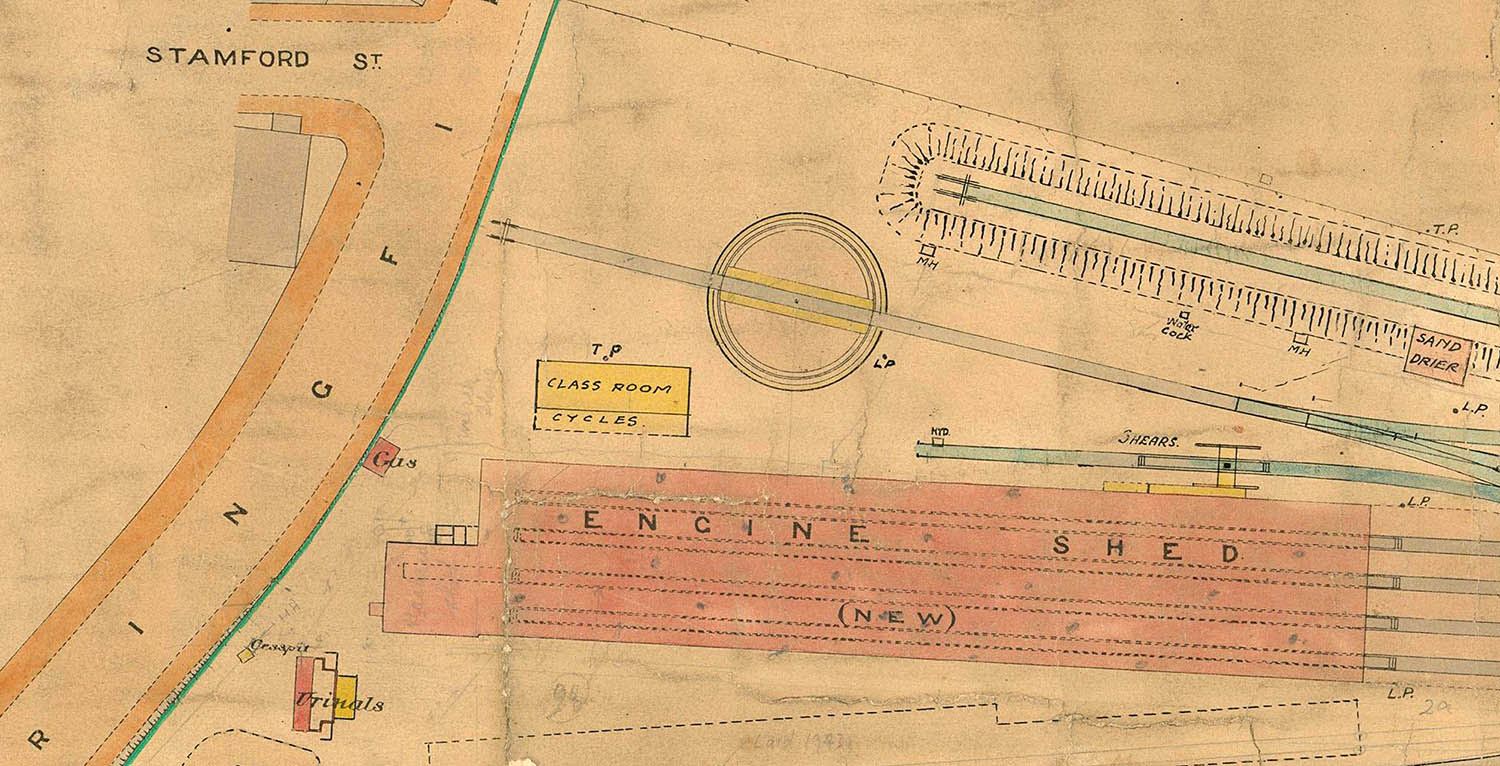
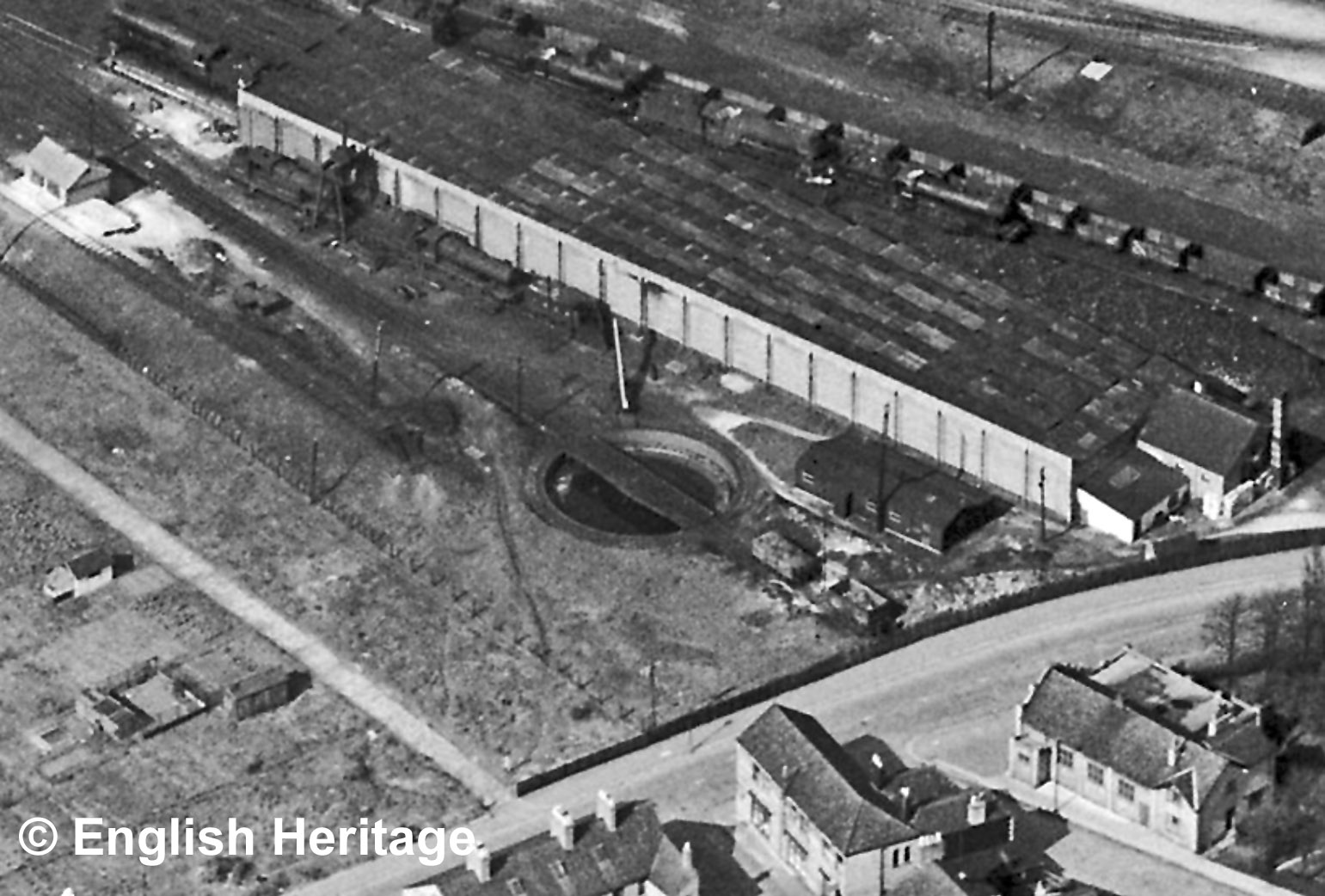
© English Heritage https://britainfromabove.org.uk/en/image/EAW028683
Accident on Monday 26th August 1915
(from The Grantham Journal of 31st July 1915)
Locomotives in Collision – On Monday evening an accident involving damage to two G.N.R. engines, other rolling stock, and buffer stops occurred at the Springfield locomotive sheds. From information to hand, we understand that an Atlantic type engine got temporarily out of control, and collided with another locomotive of an earlier pattern that was on the turntable. The latter engine dashed with great force into two stationary tenders, which, in turn, drove the buffer stops clean out of the yard beneath the footpath on Springfield Road, the asphalt of which was dislodged. Fortunately, no one was injured, but the damage to the engines was rather extensive.
The site of this accident is shown in the aerial photograph of 1950 above; note that there are two wagons positioned where the two tenders would have been in 1915.
Giving approximately 50 years' service, 'Turntable C' was the longest-lasting of all the turntables at Grantham. During its period in use Grantham shed always had two turntables because, at the north end of the Loco yard, 'Turntable B' was replaced by 'Turntable 'D' and ' Turntable E' in succession.
'Turntable C' is said to have been out of use by 1947 [Griffiths & Hooper, GNR Engine Sheds, Vol. 1 Southern Area, page 101]. However, the aerial photographs taken over Grantham on 19th April 1950 - see above and others in the series - appear to show it in position and potentially accessible from its access siding. Nevertheless, the site was obliterated when a spur of the turning triangle was built across it in 1951.
'Turntable D': the 'large Atlantic' era
Diameter 55 feet; in service 1903 to 1921, 18 years
In 1891 the Great Northern Railway bought the former Grantham Workhouse site to enable the constricted northern end of the station and shed layout to be extended to the west in future years. The railway extended across the workhouse land in stages, demolishing the buildings and raising the lower-lying ground to track level by tipping spoil onto the site. The infilling process was probably not very carefully controlled, laying up problems for the railway which would have to be dealt with half a century later.
'Turntable D', 55 feet in diameter, was built on part of the old workhouse site in 1903. It replaced the old 40-foot diameter 'Turntable B', which was too small for newer locomotives and whose site was needed for a proposed new goods line which would be built to bypass the passenger station.
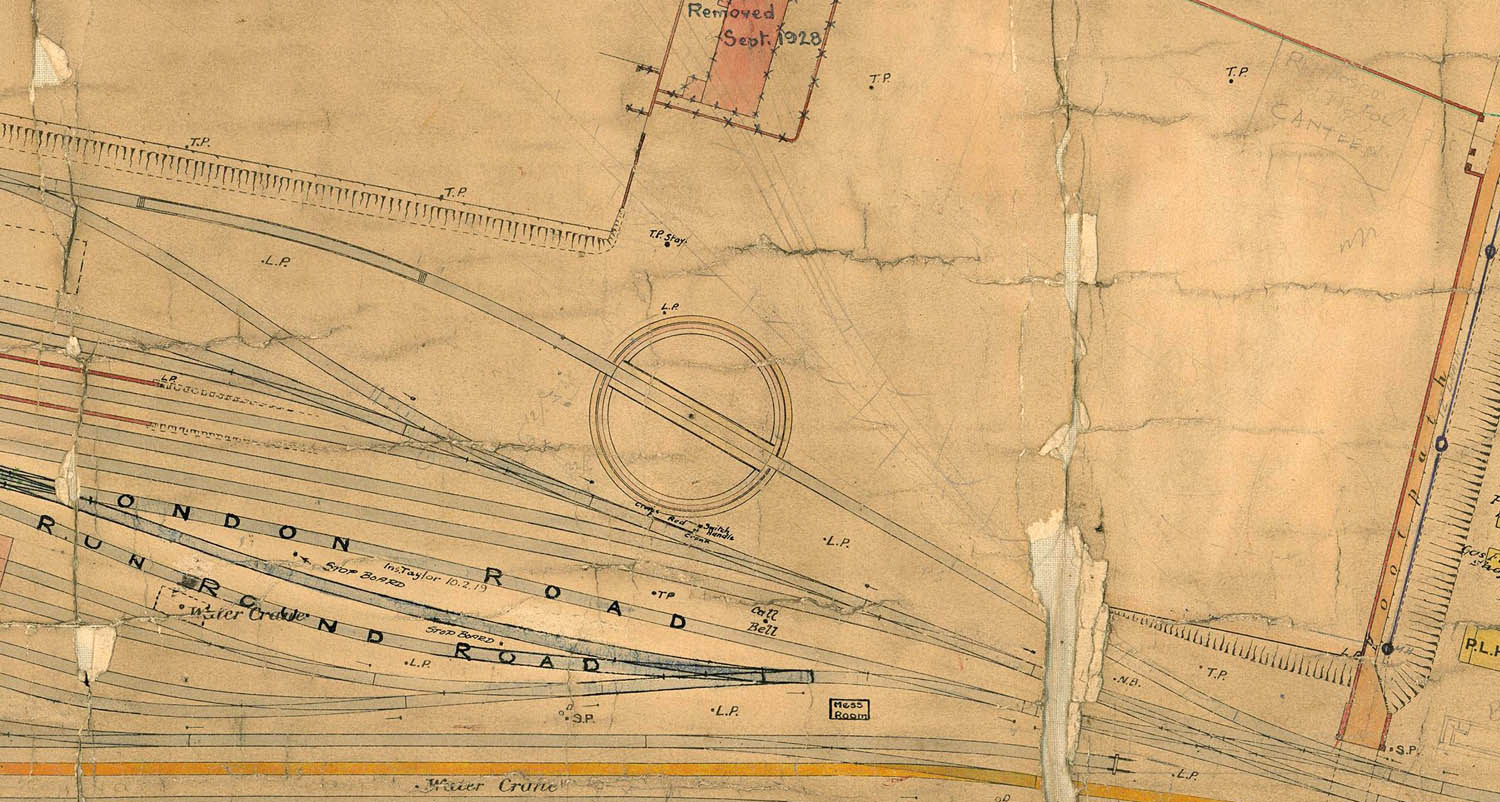

Reproduced with the permission of the National Library of Scotland.
In anticipation of the arrival of the new 'Pacific' express locomotives 'Turntable D' had to be replaced by the larger 'Turntable E' in 1921. It was in use for the shortest period of any of the Grantham turntables. However, being only 18 years old it was fit for further service and was relocated that February to the GNR's Bradford Hammerton Street loco shed.
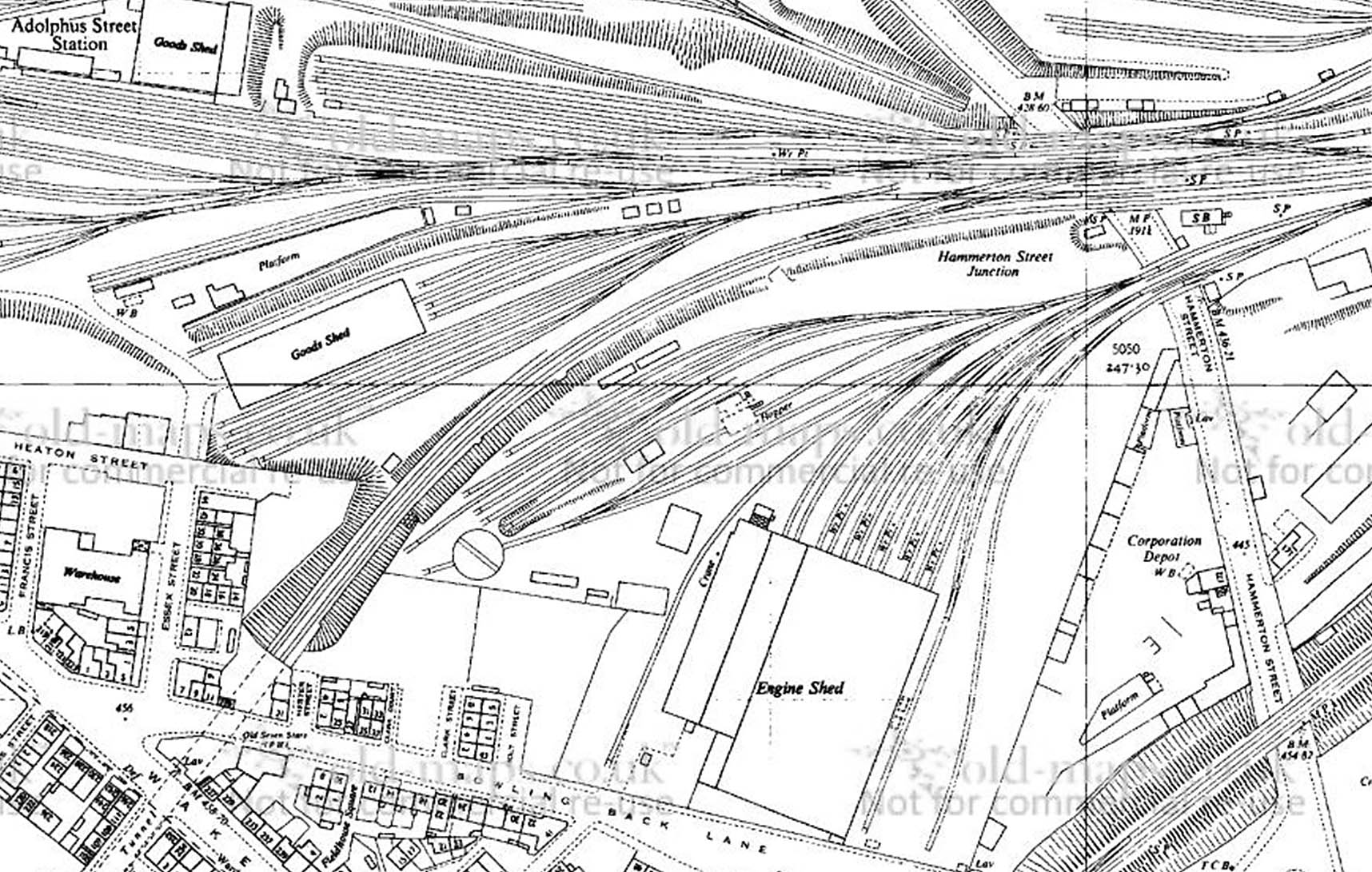
'Turntable E': the 'Pacific' era
Diameter 70 feet; in service 1921 to 1950, 29 years
At the beginning of the 1920s, with the GNR's A1 'Pacific' locomotives under construction, it was clear that Grantham Loco would need a larger turntable than those then in service ('Turntable C' of 52 feet diameter and 'Turntable D' of 55 feet diameter). So in 1921 'Turntable D' was replaced on the same site by a new 70-foot diameter turntable, 'Turntable E'.

Reproduced with the permission of the National Library of Scotland.
Photographs taken in the 1920s and 1930s show that 'Turntable E' was originally rotated manually.
Class A1 Pacific No. 2547 (later named Doncaster) is being turned at Grantham by muscle power, sometime between August 1924 and March 1926. As seen on the left, the turning effort was applied by pushing an overhanging bar at each end. The bars pivoted back when they weren't required. Mike Morant's photograph collection can be visited by left clicking on the image.
Probably taken a few moments before the previous photograph, No. 2547 has been carefully set on the turntable. The bar for pushing the turntable around is stowed out of the way. It can be seen, nearly vertical, next to the second handrail stanchion at the inner end of a slot in the turntable's deck. Mike Morant's photograph collection can be visited by left clicking on the image.

This and other photographs are available from Rail-Online: left click on the image.
By the late 1940s a vacuum-operated turning engine had been fitted, as seen in Peter Wilkinson's photographs below.

Photograph lent by Peter Wilkinson.

Photograph lent by Peter Wilkinson

The view is looking north, with the passenger station's Western Platform on the right. By reference to the locomotive's livery we know that this scene was photographed between 25th June 1948 and 13th September 1949. During this period No. 60515 was based at Heaton shed in Newcastle, so it will be being turned to face north in readiness for its return on a train bound for Tyneside.
Photograph from the M.L. Boakes Collection (contact by email), ref. 2903.
In 1950 the foundation of 'Turntable E' began to show signs of subsidence, probably due to the instability of the ground on which it stood. The ground was spoil tipped some fifty years earlier over the site of the old workhouse and here seemed little that could be done to stabilise the site. However, British Railways owned a substantial area of land to the west of the Loco where there was sufficient space for a turning triangle to be laid out, and this option was speedily implemented as described in Section 4 below.

© English Heritage https://britainfromabove.org.uk/en/image/EAW028682
Like its predecessor, Grantham's 70-foot turntable was fit for further service. It was installed at Melton Constable in Norfolk, as seen in the two photographs below, where it remained in use until 1959.
Does anyone know of any photographs showing Turntables 'A', 'B', 'C' or 'D' at Grantham? If you do please let us know.
4. Turning Triangles at Grantham
When turntable facilities at Grantham shed were temporarily unavailable because of breakdown or accident, resort was made to turning triangles. This applied permanently from 1950 when 'Turntable E' became disabled.
Barkston South and East Junctions and Allington Junction
Available 1875 to 2005, 130 years
From 29th October 1875, until the closure of Barkston East and South Junctions on 3rd October 2005, it was possible to turn locomotives using the route shown below, a 13-mile round trip.

The last-known proper turning move at Grantham took place using this route on 25th October 2003, whilst Barkston East Junction was still open. The steam loco, B1 No. 61264, arrived at Grantham from Nottingham facing the wrong way round to take forward a northbound rail tour, The Lincolnshire Poacher. It was sent from Grantham to Barkston East (tender first) via the ECML; it then made its way (facing forward) to Allington Junction finally returning (tender first) to Grantham along the Nottingham line, ready to take over the rail tour. A delay to the Empty Coaching Stock meant the tour started from Finsbury Park, and not Kings Cross as booked.
Barkston Junction - South, East and North
Available 1882 to 1972, 90 years
A shorter route, using the three legs of the triangle at Barkston Junction, was possible from April 1882 until the closure of the curve between Barkston North and Barkston East Junctions on 29th April 1972. This was a 10-mile round trip.

The Turning Triangle at Grantham Shed
In use 1951 to 1963, 12 years
When it was realised that the 70-foot turntable would be difficult to keep in service, because of unstable ground conditions, other options were considered. A normal triangle with track curvature suitable for use by express locomotives would occupy many acres of land. However, thanks to the GNR buying up more property in the 1890s than it required for its immediate needs, sufficient railway-owned land was available nearby to lay out a space-saving 'cross-legged' triangle, in which two of the sides intersected in a flat crossing. The turning triangle at Grantham shed came into use on 10th September 1951.

© English Heritage https://britainfromabove.org.uk/en/image/EAW028683

The prominent rectangle below and to the left of the flat crossing was a building intended to be used as an emergency railway control centre in the event that East Coast Main Line control staff had to be moved north during the second world war.

When Mick Grummitt was a telegraph lad on duty at the North Box one day, a train came in from the north with a hot axle box on the locomotive. The locomotive was changed and its crew, from Heaton in Newcastle, went onto 'the angle' to turn. Not being familiar with the layout they failed to stop in time and made a hole in the wall of the shed. This rendered the angle out of use until the locomotive was recovered, and engines had to travel to Barkston Junction to turn.
Grantham Loco was, we think, unique in Britain in having a turning triangle which was on shed territory and not shared by normal railway traffic. 'Going round the angle' to turn a locomotive became a well-established part of the Grantham Loco tradition. Many young cleaners had their first experience at the controls under the guidance of an experienced hand, and youngsters from Grantham railway families were taken aboard on quiet evenings for 'a trip round the angle' on the footplate.

There were three routes off the return leg of 'the angle'. The first, which gave access to the various Loco Yard facilities, is the track immediately beyond the disused gas lamppost on the left. The second exit was the track that's in shadow just beyond No. 60029. The third exit road curved round behind No. 60029's tender to join the entry road in the points that the locomotive is passing over. The warning board reminded exiting loco crew to be alert in case another locomotive was approaching the points from the opposite direction. The triangle was part of the Loco Yard and there was was no signalling.
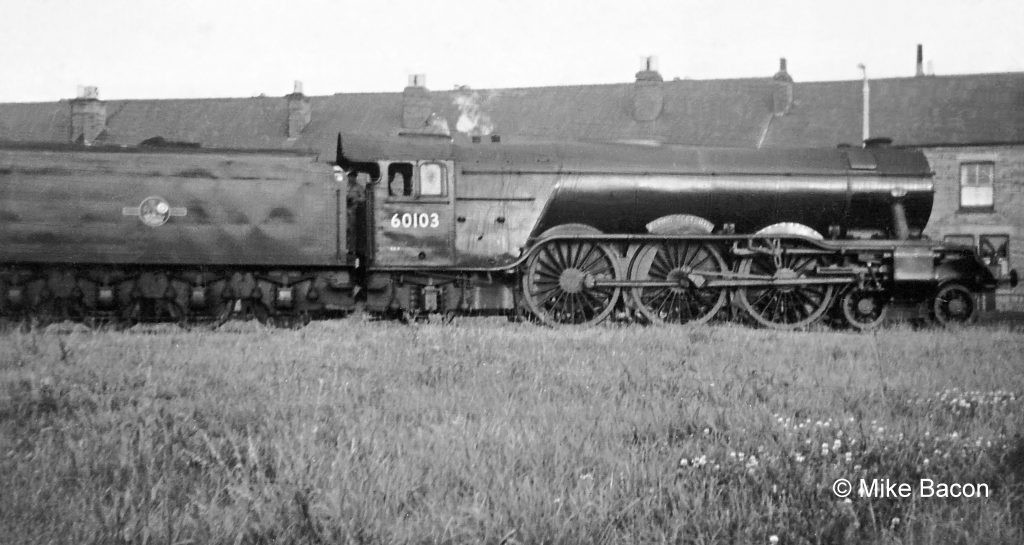
Photograph by Mike Bacon.
Turning and The High Dyke Branch
As noted earlier, it is beneficial for a locomotive to have its chimney uphill when ascending a steeply inclined section of the line. This is related to boiler safety, and the longer the boiler and the steeper the incline the more it becomes desirable that the locomotive faces uphill. From the 1940s until 1963 large heavy freight locomotives based at Grantham shed worked the steeply graded ironstone branch from Highdyke, so it was important that they were sent out from the shed facing the right direction.

Photograph by Cedric A. Clayson.
The turning triangle at Grantham Loco was in daily use for 12 years until September 1963, when the shed closed.
Allington Junction and Chord
Allington Chord opened in 2005
The Allington Chord opened on 3rd October 2005. Its principal purpose was to divert traffic between Grantham and Spalding away from the stretch of the East Coast Main Line between Grantham and the former South Junction at Barkston. This removed a junction, with its speed restriction, on the main line and introduced additional route capacity for express services.
The junctions at each apex are controlled from Allington signal box, built at the same time as the chord. It replaced the old GNR Allington Junction box which controlled the original divergence of the Grantham and Sleaford lines, now known as Allington West Junction.

The chord created a triangular junction at Allington which, in theory, could be used for locomotive turning. However, since the end of the regular use of steam locomotives turning has become unnecessary for the normal operational needs of the railway. The signalling layout at Allington does not allow for the true turning of locomotives or trains through each leg of the triangle.
These days the only feasible option is to send a locomotive from Grantham all the way to Sleaford, via the East and North Junctions at Allington, to cross over at Sleaford and return to Allington, when it can then be reversed via the West Junction; however this is time consuming and adds needless mileage - Allington to Sleaford and return is about 30 miles.
There are occasional times when a piece of engineers' (Yellow Plant) machinery needs turning round before or after a job, but this is usually achieved whilst the line(s) are under engineers' possession. This probably occurs about once or twice a year.
There are instances where an engineers' machine arriving from Sleaford, for example, towards Grantham may be the wrong way round for using the Allington Chord - these are then routed via the West Junction, from where they merely reverse direction towards Grantham.
Sources
Information for this article has been drawn from many published sources, in particular the following:
Great Northern Railway Engine Sheds - Volume 1, Southern Area by Roger Griffiths & John Hooper (Book Law / Railbus in association with Challenger (reprint), 2001)
The Layout Development of the Grantham Area Part 4: The Northern Junctions (Grantham North Jn [exclusive] to Barkston North Jn, including Ambergate Yard), parts (i) to (vi) by Don Anderson, published in Great Northern News Nos. 191 to 196 (The Great Northern Railway Society, 2013-2014)
My thanks to Andy Hides of the Grantham Railway Sports & Social Club for information about the more recent period.


![LNER, Gresley A1 pacific no. 2547 is depicted here in profile whilst being turned at Grantham shed with the station in the background. 2547 had entered revenue earning service on 30/8/1924 but wouldn't be named Doncaster until March 1926. The loco's name, incidentally, doesn't refer to the location but to the horse that won the 1873 Derby at Epsom.[Mike Morant collection]](https://mikemorant.smugmug.com/Trains-Railways-British-Isles/LNER-and-BRE-and-BRNE/LNER-post-grouping-locomotives/LNER-A3/i-c7LNkKj/0/799bd480/960x640/E_LNER_2547_Grantham_mpd-960x640.jpg)



A brilliant article, many thanks. I saw many locos turned on the triangle and to see one of these beasts close up on Springfield Road was awe inspiring.
Thanks very much Tim - it's been an interesting piece of work to do.
John
A fascinating and important piece of research. Well done John.
Thanks for that Kevin. There are still a few corners to fill out and I hope more information will come to light.
John
Thank you and most interesting.
Rich.
Hello Rich,
Thanks for getting in touch. It's always good to receive positive feedback.
John Clayson
A very interesting and informative article.
Many thanks
I have just got round to reading the article on turntables and found it very interesting. From one of the pictures and a map of the early 1900 hundreds that shows the current roads faintly underneath I have been able to locate my property. I found that it is located just outside the boundary fence opposite the south end of the coaling stage when the site was extended for the reversing triangle.
Hello Bob,
It's good to hear from you. It was an interesting page to research a couple of years ago when I discovered what a relatively complex story it was. Reading the page again recently it didn't 'flow' very well in places so I decided to revise it.
What a view there would have been from your house if the shed had still been there, and full of steam locos! Though I expect you and your neighbours would've had problems with smoke and smuts when the wind was from the north east.
All the best,
John
I lived in Lincoln in the 50s and my family would visit my uncle and aunt who lived in Springfield Road. The visits were made bearable to a teenager because of the turning triangle and your article has brought back many happy memories of those train-spotting days. Thank you.
John Worsfold.
Hello John,
Thank you for your comment. We’re always delighted when someone adds a personal recollection because every contribution enriches the story of the railway in and around Grantham.
John Clayson
I had just passed out as a fireman at top shed, King's Cross. My first firing turn on the main line was on 60157 Great Eastern, train to Leeds,
we work it as far as Grantham and got relieved, had a break and collected our return engine 60103 Flying Scotsman. My driver
instructed me to put plenty of coal in the firebox before we depart. I learnt why. To Peterborough you're unable to fire, just sit in your seat and hang on going down Stoke Bank. 60103 needed a works visit but she was a good steamer, like all the Greasley pacifics. Happy Days.